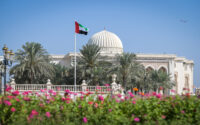Jebel Jais – Pushing Ras Al Khaimah’s Tourist Sector To New Heights
There can be no better symbol for the tourism aspirations of the Emirate of Ras Al Khaimah than Jebel Jais, the tallest mountain in the UAE. Reaching almost two kilometers in height, this imposing feature stands out against the impressive contours of the Hajar Mountains and – thanks to a new focus in tourism – has come to represent Ras Al Khaimah’s ambitions in this sector, both literally and figuratively.
In a literal sense, the mountain is the center of a new tourism paradigm for Ras Al Khaimah based on adventure, sustainability and eco-tourism, while metaphorically, its elevation as the UAE’s tallest point represents the heights that Ras Al Khaimah’s new tourism strategy aims to reach.
The new direction can be traced to the decision of His Highness Sheikh Saud bin Saqr Al Qasimi, UAE Supreme Council Member and Ruler of Ras Al Khaimah, to unlock the potential of the Emirate’s most stunning natural feature. The plan, as it evolved, was to exploit Ras Al Khaimah’s outstandingly beautiful and rugged topography and its cooler mountain climes to create a unique tourist offering far removed from the rolling dunes that are synonymous with the region.With temperatures at the summit of Jebel Jais often 100C cooler than those at sea level, the aim was to create a new center of tourism that would be attractive to visitors year-round, even during the otherwise inhospitable outdoor months of the UAE summer.
Central to the strategy is sustainability, which is a key priority for Ras Al Khaimah and encompasses the ongoing development of renewable energy sources, recycling and protecting the Emirate’s ecology. The commitment to this can be seen in the work to proliferate native flora at the summit of Jebel Jais and its surrounding areas, through to the policy being the underlying principle guiding the development of the mountain’s public areas.
One vital aspect of this direction is to ensure accurate documentation of Jebel Jais’ native plant species to create a database that will help assist with conservation measures, as well as provide information for nature lovers visiting the mountain. To this end, the Emirate is drawing on the expertise of Dr. Marina Tsaliki, Plant Conservationist and Research Specialist at Ras Al Khaimah Public Services Department’s Landscape Agency, who is tasked with identifying Jebel Jais’ variety of wild plants and making recommendations on how they can be protected and even utilized for the benefit of the community. As she explained:
“When I started working on Jebel Jais, the first thing I did was document the plants found there. I have now mapped them all and have established that the mountain has more than 100 different species, meaning that there is rich diversity. As far as we know, some species – such as its lily and iris – are unique to Jebel Jais and are not found anywhere else in the UAE. I’ve also found an abundance of herbal plants, aromatic plants and plants that are used for medicinal purposes. I’m currently looking at other mountaintops in the region just to confirm how unique Jebel Jais’s flora truly is.”
The expert botanist described how the plants and shrubs with medicinal properties that she has documented may have pharmaceutical applications and explained that she is currently assessing their viability for use in this area. She also discussed the wild types of popular fruit and nut she had found on the mountain, saying that these are very different to the cultivated versions grown for consumers.
“There are wild figs growing on the mountain, but not like the sweet ones that you would buy in the shops. They’re not really meant for human consumption but they support wasp communities that pollinate them and insects and animals that feed on them. This makes them an important part of the mountain’s ecosystem. We also have Arabian almonds and these are currently undergoing laboratory analysis to determine their exact chemical composition and type. Although most of the plants on Jebel Jais are not a food source for humans, many of them could have important medicinal uses – that’s something I’m currently looking into,” she added.
By opening up Jebel Jais and promoting it to a new segment of traveler, it was envisaged that Ras Al Khaimah would develop a reputation as an exciting new destination that would appeal in particular to adventurers, day-trippers, hikers and nature lovers. It was decided that one of its first attractions would be a zipline from Jebel Jais – not just any zipline, but the world’s longest and a feature that would serve to attract thrill-seekers from around the world.
But first a road needed to be built and this was a tall order. Until as recently as 2013, the only way to ascend the mountain was by foot or by helicopter, so to allow for proper access and ongoing development, a road that would enable visitors to easily and efficiently traverse the imposing peak road had to be constructed. And building a road up such a precipitous feature, with its severe inclinations and dizzying drops, was not without significant challenges.
It is thanks to the incredible efforts of both the contractors involved and Ras Al Khaimah Public Services Department that oversaw the operations that Jebel Jais now has a high-quality access road taking visitors from the base of the mountain to the UAE’s highest point. Such has been the scale of this work that the Public Services Department is currently pursuing a Guinness World Record title for the construction of the road’s retaining walls, which are likely to be the longest in the world. Adding to its list of impressive engineering achievements, the road has already been mentioned as among the world’s best driving experiences by the international motoring media.
His Excellency Eng. Ahmed Mohammed Al Hammadi, Director General of the Public Services Department, said that construction of the 36km road was a challenging process but one that reaped great rewards.
“The Public Services Department successfully completed what is a unique mountain road to global specifications and with nine huge, distinctive retaining walls,” he noted. “The gradient ranging between 2% and 6% means that the road is suitable for cyclists. It includes about 20 rest stops, offering charming panoramic views of the mountain range.”
“This road is one of the most important and expensive projects in Ras Al Khaimah and was completed in a relatively short period of time, opening up Jebel Jais to a multitude of important tourism projects, all with the support, encouragement and planning of His Highness Sheikh Saud bin Saqr Al Qasimi, UAE Supreme Council Member and Ruler of Ras Al Khaimah,” he added.
When the road construction was nearing completion, Ras Al Khaimah Tourism Development Authority (RAKTDA) looked at how to build a zipline that would capture the headlines and help Jebel Jais make its name. After extensive research and due diligence, RAKTDA entered into a partnership in 2017 with Toro Verde, operators of ‘ElMunstruo’ (‘The Monster’) – the then world’s longest zipline located in Puerto Rico in the Caribbean. Toro Verde’s zipline experts were brought in to manage and operate Jebel Jais Flight, the development of which entailed some substantial engineering feats, such as a glass-floor platform and a landing area suspended in mid-air.
The efforts of the Public Services Department and RAKTDA paid off and a new Guinness World Record of 2.83km for a zipline was set. With participants hurtling over the mountain landscape head-first at speeds of up to 150kph, Jebel Jais Flight is an adrenaline addict’s delight and has garnered global media coverage that has further broadcast its appeal, leading to it becoming a hugely popular ‘bucket list’ attraction.
The partnership to create Jebel Jais Flight is an example of Ras Al Khaimah’s plan to encourage more international companies to enter into joint development projects with local entities, with the attraction of foreign expertise, as well as investment, an important aspect of the Emirate’s vision and overall economic development plans. The establishment of the zipline marked the beginning of Jebel Jais’ positioning as a new and exciting adventure tourism destination, with further elements soon following to create a comprehensive adventure hub. As Raki Phillips, CEO of RAKTDA, outlined:
“The launch of Jebel Jais Flight cemented Ras Al Khaimah’s place on the map as an adventure destination, but it is just one aspect of what we now offer. The Emirate’s diverse landscape is perfectly suited to an array of outdoor activities and this has enabled it to make a name for itself by offering a range of invigorating pursuits that include hiking, biking, climbing, trekking abseiling and canyoning, all with the help of adventure tour companies that provide certified and knowledgeable guides,” he said.
“We have expanded on the exciting appeal of Jebel Jais by launching the all-encompassing Jais Adventure Peak that provides access to the Emirate’s series of exciting adventure activities. This spans the Jebel Jais Flight; Jais Sky Tour, featuring seven ziplines and a 15-meter long sky bridge – the highest in the UAE; Bear Grylls Explorers Camp, which also includes the world’s first Bear Grylls branded accommodation;Jebel Jais Viewing Deck Park – with its seven viewing decks offering stunning 360-degree vistas of the spectacular Hajar Mountains and the Jais Sky Maze – a suspended obstacle course comprising two levels of rope swings, wobbly bridges, swinging loops and more,” he added.
Despite the situation faced by the world since the start of 2020, Jais Adventure Peak still managed to welcome more than 65,000 thrill-seekers until April 2021 and all attractions on the mountain adhere to strict sanitary measures.
“For the coming years we have ambitious goals to raise Ras Al Khaimah’s profile and establish more adventure products to attract a greater number of thrill-seekers from around the world. We recently announced a half-a-billion dirham investment plan to develop sustainable tourism projects – this underscores our commitment to driving tourism development and increasing confidence among investors and international operators in Ras Al Khaimah’s tourism future,” said Mr. Phillips.
It is anticipated that growing numbers of adventure and eco tourists will increase overall visitor figures to Ras Al Khaimah by a significant margin, thereby contributing considerably to the Emirate’s economy. The partnerships it is striking up to deliver new offerings in the adventure tourism sphere are also attracting private investment and proving instrumental in Ras Al Khaimah’s efforts to expand its name as the region’s premium adventure hub.
When H.H. Sheikh Saud first conceived the idea of developing Jebel Jais, no one could have imagined how the dream of developing a previously inaccessible, imposing feature would transform a little-known mountainous area in the north of the UAE into the spectacular tourism hub it is today. The UAE public and visitors alike can be thankful that the beautiful vistas of Jebel Jais are now accessible to all.







